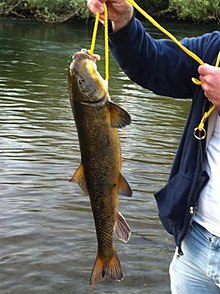Columbia River habitat
provided by EOL authors
The Columbia River Basin of western North America is an important habitat for the 61 centimeter (cm) largescale sucker (Catostomus macrocheilus). The Columbia River is the largest North American watercourse by volume that discharges to the Pacific Ocean. With headwaters at Columbia Lake, in Canadian British Columbia, the course of the river has a length of approximately 2000 kilometers and a drainage basin that includes most of the land area of Washington, Oregon and Idaho as well as parts of four other U.S. states and two Canadian provinces. The hydrology and aquatic habitat of the Columbia River basin has been adversely altered by numerous large dams. There are over 250 reservoirs and around 150 hydroelectric projects in the basin, including 18 mainstem dams on the Columbia and its main tributary, the Snake River. Water quality has deteriorated over the last century, due to agricultural runoff and logging practices, as well as water diversions that tend to concentrate pollutants in the reduced water volume. For example nitrate levels in the Columbia generally tripled in the period from the mid 1960s to the mid 1980s, increasing from a typical level of one to three milligrams per liter. Considerable loading of herbicides and pesticides also has occurred over the last 70 years, chiefly due to agricultural land conversion and emphasis upon maximizing crop yields. Heavy metal concentrations in sediment and in fish tissue had become an issue in the latter half of the twentieth century; however, considerable progress has been made beginning in the 1980s with implementation of provisions of the U.S.Clean Water Act, involving attention to smelter and paper mill discharges along the Columbia. Other large demersal vertebrate species occurring in the Columbia Basin are 76 cm Pacific lamprey (Lampetra tridentata), the 55 cm Brown bullhead (Ameiurus nebolosus);; the 64 cm longnose sucker (Catostomus catostomus catostomus); and the 65 cm Utah sucker (Catostomus ardens). Other large benthopelagic fish in the Columbia are the 63 cm northern pikeminnow (Ptychocheilus oregonensis) and the 45 cm Tui chub (Gila bicolor).
- bibliographic citation
- C.Michael Hogan. 2012. Columbia River. Eds. P.Saundry & C.Cleveland. Encyclopedia of Earth. National Council for Science and the Environment. Washington DC
- author
- C. Michael Hogan (cmichaelhogan)
Trophic Strategy
provided by Fishbase
Occurs in pools and runs of medium to large rivers. Also found in lakes. Pelagic up to 1.8 cm in length (Ref. 1998). Young feed on planktonic cladocerans, copepods, ostracods, and mites; chironomid, trichopteran and ephemeropteran larvae; and bottom ooze (Ref. 1998). Adults feed on algae, diatoms, insects, amphipods, and mollusks (Ref. 1998). May feed on salmonid eggs (Ref. 1998). Preyed upon by mergansers, osprey, eagles, and bears (Ref. 1998).
Biology
provided by Fishbase
Occurs in pools and runs of medium to large rivers. Also found in lakes. Pelagic up to 1.8 cm in length (Ref. 1998). Young feed on planktonic cladocerans, copepods, ostracods, and mites; chironomid, trichopteran and ephemeropteran larvae; and bottom ooze (Ref. 1998). Adults feed on algae, diatoms, insects, amphipods, and mollusks (Ref. 1998). May feed on salmonid eggs (Ref. 1998). Preyed upon by mergansers, osprey, eagles, and bears (Ref. 1998). Edible but not highly favored (Ref. 1998).
Importance
provided by Fishbase
fisheries: commercial; aquarium: public aquariums
Largescale sucker
provided by wikipedia EN
The largescale sucker (Catostomus macrocheilus) is a species of sucker, a type of freshwater fish, found in western North America.[1]
Description
It has a rounded snout with a downturned mouth on its underside (as opposed to a mouth at end of the head like most fish). It has large scales and narrow tail base (caudal peduncle).
Juveniles are under 4 in (10 cm) in length. Adults can reach a length of 24 in (61 cm) and 7 lb (3.2 kg) in parts of their range.[2] Juveniles are mottled brown or olive green with dark spots and white to yellow belly. Adults are bronze to orange on top with lighter undersides.
Distribution and habitat
The largescale sucker is native to the Pacific Northwest, occurring from British Columbia south to Oregon. It is widespread in the Columbia River system. It occurs in the slower-moving portions of rivers and streams, and in lakes.
Biology
Largescale suckers spawn in the spring in shallow water over sandy areas of streams or the sandy or small gravel shoals of lakes. Females may produce up to 20,000 adhesive eggs. The young feed upon small zooplankton until they become bottom dwellers. Then they feed on benthic aquatic invertebrates, diatoms, and other plant material. They are an important part of the food web and the diet of fish-eating animals (such as osprey, eagles, river otters, and other fish).[3]
Angling and relationship with humans
Largescale suckers, and rough fish in general, have been used as scapegoats for human impacts on fisheries. Ignorance about suckers is widespread and many anglers in the Pacific Northwest kill them because they mistakenly believe them to have a negative impact on salmon and trout stocks.[4] The International Game Fish Association all tackle world record stands at just 3 lb 11 oz (1.7 kg) caught in Kalispell, Montana.[5] However the Idaho state record sits at 9 lb (4.1 kg) and a 27.7 in (70 cm) fish stands as the catch and release record.[6]
References

- license
- cc-by-sa-3.0
- copyright
- Wikipedia authors and editors
Largescale sucker: Brief Summary
provided by wikipedia EN

Catostomus macrocheilus
The largescale sucker (Catostomus macrocheilus) is a species of sucker, a type of freshwater fish, found in western North America.
- license
- cc-by-sa-3.0
- copyright
- Wikipedia authors and editors


 Catostomus macrocheilus
Catostomus macrocheilus